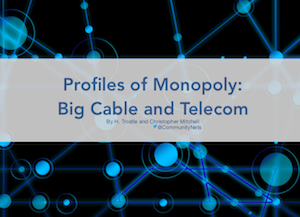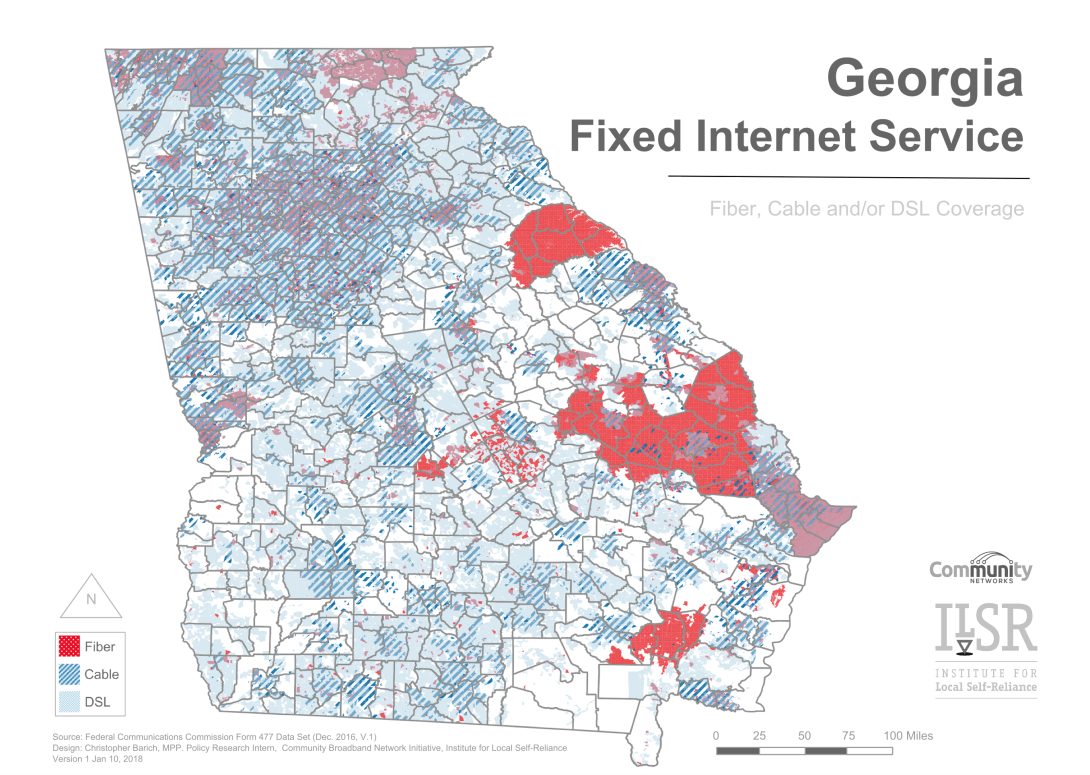
Fast, affordable Internet access for all.

People in Arkansas who depend on Medicaid for healthcare typically don’t have the option to sign-up for affordable health insurance through their jobs. Sometimes they aren’t able to find full-time positions that offer healthcare or they don’t earn enough to afford the premiums in addition to covering life expenses for their families. With so many people offline, either because they can’t afford to pay for connectivity or because they live in areas where there is no connectivity, Arkansas seems like a poor choice for mandatory online reporting of anything, especially activity that dictates eligibility for Medicare.
State leaders didn’t see it that way, however, when they implemented the policy in June. Medicaid recipients who are able to work must now go online to report at least 80 hours per month of activity; if they fail to do so, they lose access to the state's expanded Medicaid program. The activity can include volunteer work, job training, or several other categories of activities. While the issue of attaching work requirements to Medicaid eligibility has already been deemed arbitrary and capricious by a U.S. District Court in Kentucky, the lack of Internet access appears to be contributing to Arkansas’s dubious efforts to trim its enrollment.
 Lack of Coverage Complicates
Lack of Coverage Complicates
In a state where at least 30 percent of the population has access to only one Internet service provider (ISP) and approximately 20 percent depend on their smart phones for Internet access, the only way to report the new work-related requirement is online. Under the guide of cost savings, the state has not established any other method for reporting for those who don’t have access to the Internet.

If you haven’t already taken a look at our most recent report, now is your chance to get some insight before you download it and dive in. Profiles of Monopoly: Big Cable and Telecom, written by our Hannah Trostle, recently left ILSR to attend grad school, and Christopher Mitchell, transforms FCC Form 477 data into a series of maps that reveal a sad state of competition in the U.S. broadband market. For episode 317 of the podcast, Hannah and Christopher discuss the report and the main findings.
Hannah and Christopher provide more insight into the main findings of the report, which analyzes where competition exists and where large national providers fail to invest. The result ultimately creates densely populated areas with more competition for broadband (as defined by the FCC) than rural areas. Due to their de facto monopolies, the top national providers capture huge segments of the population.
Hannah and Christopher also talk about the quality of the Form 477 data and the need for better benchmarks, we learn about why Hannah and Christopher felt that it was time to take the data and turn it into a visual story. You’ll learn more about their methodology in developing the maps and their analysis. Hannah, who created the maps that make the foundation of the report, shares some of the surprises she discovered. The two talk about the Connect America Fund and the policies behind the program and how the results have aggravated lack of broadband in rural America and how cooperatives are picking up the slack where big corporate ISPs are failing rural America.
 If you want to learn more about how cooperatives are running circles around the big ISPs in rural areas, download our 2017 report, Cooperatives Fiberize Rural America: A Trusted Model for the Internet Era.
If you want to learn more about how cooperatives are running circles around the big ISPs in rural areas, download our 2017 report, Cooperatives Fiberize Rural America: A Trusted Model for the Internet Era.
This show is 37 minutes long and can be played on this page or via Apple Podcasts or the tool of your choice using this feed.
Transcript below.
We want your feedback and suggestions for the show-please e-mail us or leave a comment below.
Listen to other episodes here or view all episodes in our index. See other podcasts from the Institute for Local Self-Reliance here.
Thanks to Arne Huseby for the music. The song is Warm Duck Shuffle and is licensed under a Creative Commons Attribution (3.0) license.
For years, national cable and telecom companies have complained that they work in a tough industry because “there’s too much broadband competition.” Such a subjective statement has created confusion among subscribers, policy makers, and elected officials. Many people, especially those in rural areas, have little or no choice. We wanted to dive deeper into the realities of their claim, so we decided to look at the data and map out what the large carriers offer and where they offer it. In order to share our findings with policy makers, local elected officials, and the general public, we’ve created a report that includes series of maps to illustrate our findings and our analysis, Profiles of Monopoly: Big Cable and Telecom.
Choice: The Ultimate Prize
Whether it’s a brand of breakfast cereal, a model of car, or an Internet Service Provider (ISP), those who purchase a good or service know that when they have more options, the options they have are better. The FCC defines "broadband" as connectivity that provides speeds of at least 25 Megabits per second (Mbps) download and 3 Mbps upload; our report fouces on service where ISPs claim to offer this minimum threshold.
When it comes to ISPs, subscribers often have a faux choice between unequal services, such as one telephone company offering slow DSL and one cable company that offers faster cable Internet access. People in rural America often have even slimmer options because cable ISPs don’t provide broadband in less populated rural areas. In other words, the market has spoken and the market is broken.
Hillsboro, Oregon, has studied the possibility of investing in high-quality fiber connectivity for residents and businesses since 2014. After considering the pros and cons, this northwest city of 105,000 has decided to move ahead, with spring 2019 as a target launch date of its own Internet access service.
Communications Utility and Beyond
In January, the City Council approved establishing a communications utility, creating a communications fund, and taking the necessary steps to develop a dig once policy in the city’s code. Elected officials had not yet decided if the community would pursue a city-wide network, but wanted to create an environment that would offer future options and encourage private sector partners to invest in Hillsboro.
The city already owns fiber optic resources that it uses for municipal facilities, schools, traffic signals, and other purposes. They plan to use that network as a foundation to expand in order to bring better connectivity throughout the community. With a wider network, Hillsboro hopes to adopt public Wi-Fi, better public safety notifications, and applications for smart-meters for utility services as well as real-time parking and traffic updates.
Keeping it Affordable for All Segments
Hillsboro plans to offer gigabit connectivity at around $50 per month but hopes to provide the same symmetrical service to lower-income households at a lower rate. In addition to equitable access for all income levels in Hillsboro, the city wants to ensure that students have the ability to compete.
“For our students, for our businesses, and for our entire community, we are moving forward now to expand the City’s fiber network to include Internet service,” said Hillsboro Mayor Steve Callaway. “We want to ensure affordable, equitable high-speed access to keep Hillsboro competitive with cities around the world."
The city wants to ensure that network neutrality protections remain in effect in the community for individuals and businesses. Encouraging entrepreneurs and making high-quality access with good customer service affordable for all subscribers are more goals they intend to pursue.
Incremental
Internet access isn't effective when it takes forever to load a single webpage or when subscribers spend hours babysitting their computers to ensure files make it through the upload process. At the Institute for Local Self-Reliance, we create maps analyzing publicly available data to show disparities in access and highlight possible solutions. We've recently taken an in-depth look at Georgia and want to share our findings with two revealing maps. According to the FCC's 2018 Broadband Deployment Report, 29.1 percent of the state's rural population lacks broadband access, but only 3 percent of the urban population shares the same problem. Cooperatives and small municipal networks are making a difference in several of these rural communities.
Technology Disparities Across the State
The map below shows what kinds of technology Internet Service Providers (ISPs) are using to offer Internet service to homes or businesses in Georgia. To differentiate areas of the state, the lines represent the subdivisions within counties. Our analysis focuses on wireline technologies, specifically fiber, cable, and DSL. Satellite and fixed wireless services are too dependent on the weather and the terrain for our analysis.

In rural Georgia, premises with wireline access most often rely on DSL; cable and fiber tend to be clustered around towns and cities where population density is higher. Google, for instance, operates a fiber network within Atlanta, Georgia. The large amount of fiber in the eastern half is the Planters Rural Telephone Cooperative, one of the many rural cooperatives that are taking steps to help rural communities obtain the access they need to keep pace with urban centers.

Early last year, Connect Your Community and the National Digital Inclusion Alliance released a well-researched and compelling case that AT&T had engaged in digital redlining of Cleveland, refusing to upgrade Internet access to neighborhoods with high poverty rates. In episode 290 of the Community Broadband Bits podcast, we check in to learn more and discuss key lessons.
Angela Siefer, executive director of NDIA, and Bill Callahan, President and Director of Connect Your Community in Cleveland, explore what is happening both in Cleveland and other metro centers where low-income residents are often over-paying for services far slower than are available in higher-income neighborhoods.
This discussion covers important ground, not just describing the problem but discussing how the easiest solution (forcing AT&T to upgrade areas it has neglected) is not sufficient. Also, there is sports talk at the beginning but then the host gets himself under control and focuses on what is important in this conversation.
This show is 35 minutes long and can be played on this page or via Apple Podcasts or the tool of your choice using this feed.
Transcript below.
We want your feedback and suggestions for the show-please e-mail us or leave a comment below.
Listen to other episodes here or view all episodes in our index. See other podcasts from the Institute for Local Self-Reliance here.
Thanks to Arne Huseby for the music. The song is Warm Duck Shuffle and is licensed under a Creative Commons Attribution (3.0) license.
On November 15th, the City of New York announced that it was looking for ideas to bring high-quality connectivity to every resident and business. Their goal is to get every one connected by 2025; they’re starting with a Request for Information (RFI) to solicit ideas for potential strategies and partnerships. Responses are due January 19th.
The Big Apple’s effort comes on the heels of San Francisco’s decision to invest in municipal broadband to connect the entire city. New York’s RFI states that they will use all their assets — from rooftop to, to poles, to organizational resources — to move their efforts along so New Yorkers can enjoy fast, affordable, reliable connectivity. City leaders want to exhaust all avenues and are encouraging both public and private sectors to become involved in the initiative.
The Vision
In their vision, New York City leaders have identified five goals they wish to achieve through better broadband infrastructure:
Promote competition in the residential and commercial broadband markets.
Provide high-speed residential Internet service for low-income communities currently without service.
Increase investment in broadband corridors to reach high-growth business districts, with a focus on outer-borough neighborhoods.
Promote seamless user experience across public networks to create high speed access across the boroughs.
Explore innovative ways to provide high-speed Internet to homes, businesses, and the public.
At this point, they’re open to any technology or business model that can achieve these goals and is future proof.
Resources
Large, corporate providers like AT&T have to make shareholders happy, which is why they shy way from investing in regions where they don’t expect much profit. Routinely, those areas include sparsely populated rural communities and urban neighborhoods traditionally considered low-income. Often low-income neighborhoods also include a high percentage of people of color. Attorney Daryl Parks of ParksCrump, LLC, recently filed suit with the FCC on behalf of three residents in Cleveland who are victims of AT&T's "digital redlining."
The Data Tells The Story
In March, the National Digital Inclusion Alliance (NDIA) and Connect Your Community (CYC) released a report on digital redlining in low-income neighborhoods in Cleveland. “Digital redlining” refers to AT&T’s investments in infrastructure, which improve connectivity in areas where they serve, except for neighborhoods with high poverty rates. CYC and NDIA analyzed form 477 data submitted by the telecommunications company and noticed a pattern. The revelations in that report helped the plaintiffs understand their situation and choose to ask the FCC to look deeper into AT&T's questionable business practices.
The event that inspired the analysis was the AT&T DirecTV merger. As part of the merger, AT&T agreed to create a low-cost Internet access program for customers under a certain income level. The speed tier was only 3 Megabits per second (Mbps) download, but AT&T infrastructure investment in Cleveland lower income neighborhoods was so outdated, residents could not obtain those minimal speeds. As a result, they were deemed ineligible for the program.
The Case
The complainants are three African-American residents in Cleveland’s lower income neighborhoods who can’t take advantage of the affordable program mandated by the merger because they can only access speeds of up to 1.5 Mbps download or less. Without the infrastructure to connect at higher capacity, they’ve ended up paying higher rates for slower Internet access.
In a press release on the complaint, Parks stated:
State Scoop - May 26, 2017
A new tool released by the state's technology agency is being used to refine coverage data reported by the FCC and open the way for new funding opportunities.
North Carolina's state technology agency launched a new tool for measuring broadband speeds across the state Wednesday as part of long-term infrastructure planning that could bring new connectivity to rural areas.
...
A fact sheet published by the Institute for Local Self-Reliance shows that North Carolina has a deeply stratified rural-urban divide when it comes to broadband. Christopher Mitchell, ILSR's director of community broadband networks, blames the state's regulations for the disparity.
"The state perversely discourages investment from local governments and cooperatives," Mitchell writes in a 2016 report summary.
A 1999 statute limits the ability of electric cooperatives access to capital for telecommunications, while a 2011 law limits the power of local governments build internet networks.
In an email to StateScoop, Mitchell said North Carolina is "far too focused on AT&T and Charter. It is a real shame."
Disputes over how to fund the state's rural broadband efforts have been an ongoing debate in recent years. A plan sketched by former Gov. Pat McCrory had theoretically positioned all residents in the state with connectivity by 2021. Mitchell argues that the state is ignoring some of its best options by depending on a private market that has thus far consistently failed to serve certain areas of the state.
This is the transcript for episode 245 of the Community Broadband Bits Podcast. Brough Turner of Netblazr joins the show to explain point-to-point wireless service. Listen to this episode here.
Brough Turner: Here's the deal. It's $59.95 a month. No contracts. No teaser rates. No special deals. But we're not pulling any funnies on anybody and you can leave at any point.
Lisa Gonzalez: This is Episode 245 of the Community Broadband Bits Podcast from the Institute for Local Self-Reliance. I'm Lisa Gonzalez. NetBlazr is a Boston wireless Internet service provider that focuses on urban delivery of high-quality Internet access. This week, Brough Turner, founder and chief technology officer, connects with Christopher to talk about the ins and outs of providing the point-to-point wireless service in an urban area. Brough gets into the technology and the guys discuss what might be in the future of wireless. Brough also shares his company's experience as a startup, some of the challenges they faced, and how NetBlazr is keeping up with demand. Check out their website, NETBLAZR.com, to learn more about the company, the technology, and the team. Here's Christopher talking with chief technology officer and founder of NetBlazr, Brough Turner.
Christopher Mitchell: Welcome to another edition of the Community Broadband Bits Podcast. I'm Chris Mitchell. Today I'm speaking with Brough Turner, the founder and chief technology officer for NetBlazr. Welcome to the show.
Brough Turner: Thank you.
Christopher Mitchell: We'll get into this in a second, but NetBlazr's a wireless firm. We're going to talk a lot about wireless technologies. Maybe you can just tell us a little bit about what you know about wireless networks. I guess a different way of saying that would be, tell the audience why they should listen to you.